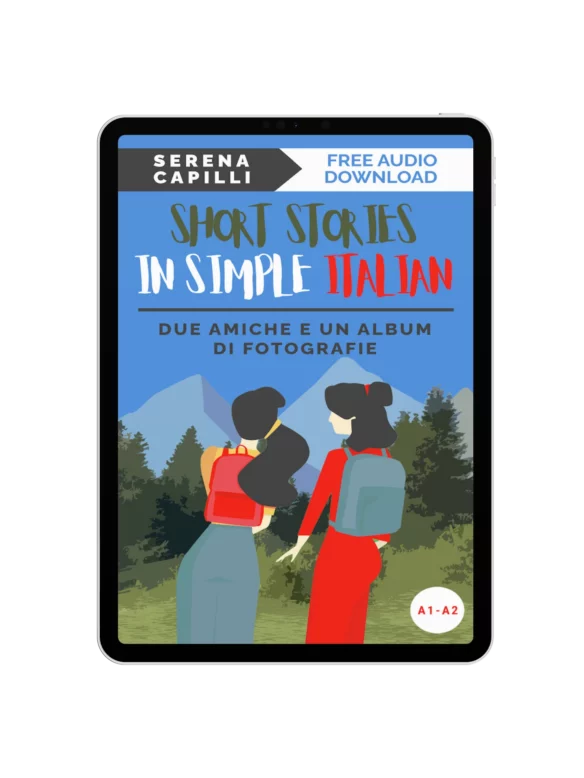Think you can handle that rolled R, those double consonants, and tricky sounds like GN and GL? Let’s find out with some fun tongue twisters in Italian!
In Italian, they are called scioglilingua, which literally means “tongue looseners,” and they’ll seriously put your pronunciation skills to the test. They’re basically word games made up of phrases that don’t really make much sense, but are designed to practise tricky sequences of sounds. There’s an iconic scene from the 60s movie I Complessi where the character played by Alberto Sordi totally blows everyone away with his ability to nail tongue twisters during a test to become a newsreader.
So, want to give it a try? Below, you’ll find 15 classic Italian tongue twisters to challenge yourself with. Start slow, enjoy the sounds, and when you’re ready, pick up the pace and let the chaos begin. Don’t worry if you mess up—we Italians get them wrong too all the time. Honestly, it’s all part of the fun!

1. Apelle figlio di Apollo fece una palla di pelle di pollo.Tutti i pesci vennero a galla, per vedere la palla di pelle di pollofatta da Apelle, figlio di Apollo.
Translation: Apelles son of Apollo made a ball of chicken skin. All the fish floated up to see the chicken skin ball made by Apelles, son of Apollo.
This is hands down one of the most famous Italian tongue twisters of all time, perfect for sharpening your P sounds and improving those double Ls.
Quick history lesson: Apollo, the Greek god of pretty much everything cool (sun, medicine, arts, prophecy), wasn’t actually Apelle’s father. But Apelle earned the honorary title of “son of Apollo” because he was considered the greatest painter of ancient Greece. We’re talking about a 4th-century BC rockstar, so talented he even became Alexander the Great’s personal portrait artist!
2. Tre tigri contro tre tigri.
Translation: Three tigers against three tigers.
Short and sweet, but surely not easy! The repeated R sounds along with the rapid shifts between tre and tigri, really put your tongue’s agility to the test! Try saying it fast enough, and you’ll quickly see why this one is a real challenge.
3. Sopra la panca la capra campa, sotto la panca la capra crepa.
Translation: Above the bench the goat lives, under the bench, the goat dies.
In this classic Italian tongue twister, the alternation between the PA and PRA sounds is difficult enough, but the addition of the CA syllable elevates the difficulty. You’ll see it’s super easy to add an R in the wrong place!
Some like to get deep with this tongue twister, claiming it has a philosophical meaning, like the bench representing the boundary between life and death. When the goat is on top, life is all good. But when it’s under the bench, well… it’s game over. Whether you’re feeling the philosophical vibe or just laughing at the idea of the goat’s dramatic fate, have fun nailing those Ps!
4. Trentatré trentini entrarono in Trento, tutti e trentatré trotterellando.
Translation: Thirty-three people from Trentino came into Trent, all thirty-three trotting and toddling.
These Trentino folks surely know how to make an entrance! This lively tongue twister is perfect for practicing your rolled Rs. It plays with repeating T sounds, sometimes paired with vowels and others followed by Rs, making it a real challenge. Plus, the doubled consonants in words like tutti and trotterellando are a key element in Italian pronunciation.
5. Orrore, orrore, un ramarro verde su un muro marrone!
Translation: Horror, horror, a green lizard on a brown wall!
This tongue twister is all about about switching between single and doubled R sounds smoothly. When the R is doubled in words like orrore, you need to hit it with a strong, rolling sound. But when it’s placed between vowels, like in muro, it softens up.
6. Nove navi nuove navigano
Translation: Nine new ships sail
This phrase, built around the N sound, might seem simple at first, but don’t be fooled—it’s surprisingly sneaky! Linking all those Ns with varying vowels is tougher than it looks, seriously putting your mouth to the test. And let’s not overlook the repeated Vs, which add a bit of extra challenge, making this another fun but tricky tongue twister in Italian.
7. Li vuoi quei kiwi? E se non vuoi quei kiwi che kiwi vuoi?
Translation: Do you want those kiwis? And if you don’t want those kiwis, what kiwis do you want?
In this sentence, the UO and UE clusters can easily mess with your pronunciation if you’re not careful. Plus, there’s the WI combo in kiwi, which is pronounced like UI in Italian—yet another vowel cluster to juggle. Practice this one, and next time you visit an Italian market, you’ll be able to ask for quei kiwi with total confidence!
8. Sul tagliere taglia l’aglio, non tagliare la tovaglia; la tovaglia non è aglio, se la tagli fai uno sbaglio.
Translation: On the cutting board, the garlic is cut, don’t cut the tablecloth; the tablecloth is not the garlic, if you cut it, you make a mistake.
If you’re struggling with the GLI sound, this tongue twister is perfect for you. Non-native speakers often pronounce it as two separate sounds, G and L, but it’s actually one sound altogether. To pronounce it properly, think of saying li (like in “lip”) and then touch the palate with the middle of your tongue.
There are, however, times when you can pronounce the G and L separately. This mostly happens when GLI appears at the beginning of words, like in glicemia (blood sugar) or glicine (wisteria).
9. Dietro quel palazzo c’è un povero cane pazzo; date un pezzo di pane a quel povero pazzo cane
Translation: Behind that building there is a poor mad dog; give a piece of bread to that poor crazy dog.
This tongue twister helps you practice the ZZ sound in Italian, which is pronounced like a hard “ts.” The tricky part is when it appears in quick succession of very similar words, like pezzo and pazzo. The key is getting your tongue to make that crisp “ts” sound without slipping into a soft Z. Don’t worry, though: if you’ve already familiar with the word pizza (which I’m sure many of you master), you’re well on your way to nailing this tongue twister too.
10. Quattro gatti grossi stanno sotto quattro grossi sassi.
Translation: Four big cats are under four big rocks.
A key element in this Italian tongue twister is the hard G sound, which alternates between being paired with a vowel (like in gatti) and the rolled R sound (like in grossi). Also, the repetition of the double consonants SS and TT in words like sassi and quattro requires you to stretch them out so they don’t sound like a single letter, which takes some extra focus.
11. A quest’ora il questore in questura non c’è
Translation: At this time the commissioner is not at the police station.
This sentence is great for familiarising yourself with the QU sound, which is pronounced like “kw” in English. Here’s something to remember: QU is always followed by a vowel, while CU usually comes before a consonant and is pronounced like “koo.” One exception to this rule is cuore (heart), which uses CU even though it’s followed by a vowel. Writing it with QU is considered a big grammar mistake in Italian, so be careful!
What makes this tongue twister even trickier is that the three main words—quest’ora, questore, and questura—are nearly identical, with only a single vowel differentiating them!
12. Sessantasei assassini andarono ad Assisi tutti e sessantasei assassinandosi
Translation: Sixty-six murderers went to Assisi all sixty-six murdering themselves.
Fantasy in tongue twisters really has no limits—a bunch of murderers heading to the city of a famous saint, only to kill themselves? Maybe they couldn’t handle all the holiness and figured the best way to stop their own crimes was to put an end to it all!
Whatever the backstory, this tongue twister is a great exercise for mastering the S sound in Italian. You pronounce it with a hard /s/ when it’s doubled (like in sessantasei) or when it starts a word followed by a vowel (as in sessantasei). On the other hand, you need a softer /z/ sound similar to “zero” in English when the S appears between two vowels (like in Assisi).
13. Se sei gnomi mangiano sei gnocchi con gli occhi, con gli occhi quanti gnocchi mangia ogni gnomo?
Translation: If six gnomes eat six gnocchi with their eyes, with their eyes, how many gnocchi does each gnome eat?
This tongue twister is perfect for practicing another tricky Italian sound: GN. It might be tempting to pronounce the letters separately, like in the English word “recognise,” but in Italian, GN is a single sound. It’s a bit like the English n and y combined. Honestly, it’s way easier to say than to explain, and you’ve probably already nailed it when ordering some delicious lasagna!
You’ll also see the letter combination CH in gnocchi and occhi. While in English CH makes a soft sound, like in “chair,” in Italian, it’s pronounced with a hard K sound.
14. Ho in tasca l’esca ed esco per la pesca, ma il pesce non s’adesca: c’è l’acqua troppo fresca.
Translation: I have the lure in my pocket and I go out fishing, but the fish doesn’t bite: the water is too cold.
This phrase plays with the two different ways of pronouncing SC in Italian. When it comes before the vowels A, O, U, or a consonant (like in tasca or esca), it’s pronounced [sk], like the English word “scarf.” On the other hand, when SC is followed by the vowels E or I (as in pesce), it’s pronounced like the English “sh” sound, as in “shiver.”
15. Se l’arcivescovo di Costantinopoli si disarcivescoviscostantinopolizzasse, ti disarcivescoviscostantinopolizzeresti tu come si è disarcivescoviscostantinopolizzato l’arcivescovo di Costantinopoli?
Translation: If the Archbishop of Constantinople were to resign from being the archbishop of Constantinople, would you resign from being the archbishop of Constantinople like the archbishop of Constantinople resigned from being the archbishop of Constantinople?
Let’s wrap up this list with a real beast of a tongue twister! That massive word, disarcivescoviscostantinopolizzasse, is so long that even reading it in your head feels like an achievement. But don’t worry, it’s not as impossible as it looks.
The key is to split it into two more manageable pieces. First, disarcivescovi. Once you practice it a few times, it will come out pretty easily. Then comes the fun part: scostantinopolizzasse. You’ve got the strong SCO sound to start, then that rhythmic TAN-TIN combo, and finally, the tricky ending with those double consonants ZZ and SS. If you can master this one, you’ll officially be an Italian tongue-twisting expert! Me? I’m still working on nailing it!

Valentina Nicastro is a travel writer in love with her home country, Italy. Having travelled widely around the globe, she realised there was more to explore closer to home and decided to put the passport aside for a while. When she is not immersed in documenting Italy, you’ll find her donning her communication consultant hat, weaving words as a content writer and bridging linguistic divides as a translator.


